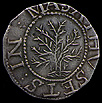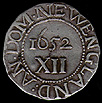Oak Tree Coinage, ca. 1660/62 - ca. 1667
Shilling
obverse |
|
reverse |
| |||
Obverse: MASATHVSETS : IN :
Reverse: NEWENGLAND : AN. DOM. [within a beaded circle] 1652
/ XII
Weight: 70.8 g (4.58grams) Diameter: 25.12 mm
Comments: This is the first issue of the Oak Tree coinage. The
obverse die is unique in that the legend begins very high with the M at
about 11:00 o'clock as is found on the Willow Tree Shillings (later Oak
Tree dies begins the legend at about 7:00 o'clock). Note that there are
small shrubs on either side of the trunk and roots below. In the center
of the coin is a dot. This is an impression in the die which was made by
a compass like instrument that was used to describe a circle on the die
to which the beads were added. The guideline can easily be seen between
the beads. Several small die breaks can be seen for example, there is a
dot just before the second S in MASATHVSETS, also there is a small hook
on the final S in the same word.
As on the obverse, the reverse also begins at 11:00 o'clock. (on later dies
it begins at about 8:00 o'clock). This is one of three reverse dies used
with obverse die 1. One other reverse (Noe 2) is similar but with a rosette
and different spacing. The third reverse is quite different with the legend
starting at 1:30 o'clock, as is the case on some Willow reverse dies (Willow
reverse dies usually start the legend somewhere from about 1:30 o'clock
to about 6:00 o'clock). On the reverse the center dot is not visible but
as on the obverse the guideline can be see between the beads. This led Noe
to surmize that the diemaker described the circle for the beads with his
compass before the date was added, for the date has removed the center mark.
Noe mentions a die a break creating a line that joined the N and the D in
ENGLAND. According to Picker this die flaw either worked itself out or was
repaired for it was not on his example nor is it on our example; the flaw
is also missing from later states of the die (Noe-Picker 1.5). As noted
by Picker there is a die break at that N which can be seen as a faint line
(Picker's dash) at the bottom serif of the N moving inward. There is also
a small dot at the final serif of that N near the rim. Also, as mentioned
by Picker, there is a long but thin die break from the center of the first
vertical stroke of the N in NEW continuing through the center stroke of
the E and ending at the serif of the start of the W. Other die breaks appear
such as: a small line at the right side of the serif in the center of the
W and as a small die break dot just after the G in ENGLAND. Picker has noted
the scratch made by the engraver into the die in the abbreviation AN. (for
ANNO) on the inside of the final serif in the N, this scratch in the die
created a line that goes to about the center stroke of that letter.
Provenance: Acquired through the Robert H. Gore, Jr. Numismatic Endowment
from the EANA November 16, 1996 Auction, lot 1.
Sixpence
obverse |
|
reverse |
| |||
Obverse: MASATHVSETS [·] IN ·
Reverse: NEWENGLAND · ANO · [within a beaded circle] 1652 / VI
Weight: 24.3 g (1.57 grams) Diameter: 19.53 mm
Comments: This is a rather well struck example that has rough surfaces, probably due to sea exposure or from having been unearthed. On the obverse the single dot following MASATHVSETS, located near the top of the S, is clipped off from this example. This is the last issue of the Oak Tree sixpence. On the obverse die the legend begins at about 8:00 o'clock as is found on all varieties of Oak Tree sixpence. Note that there is a center dot on the main trunk of the tree. This is an impression in the die which was made by a compass like instrument used to describe a circle on the die to which the beads were added. Noe comments that both the inner and outer beaded circles are well executed and round, rather than oblong. On the example shown here much of the outer circle is not present. This die variety can be easily distinguished in that the N in IN is backwards. In the original cutting (Noe 20) the first S in MASATHVSETS is weak and does not touch the inner beaded circle. On the first recut (Noe 21) that S was redone but was backwards. In the present second recut (Noe 22) that S was again redone, this time correctly oriented but enlarged so that it goes into the inner circle of beads. Also on Noe 22 the serifs at the end of the M and the start of the A have been joined.
As on the obverse, the reverse legend begins at about 8:00 o'clock (this is also the case for the die used on Noe variety 16 as well as the two other uses of the current die, Noe 20 and 21 and also on Noe 19, which is now considered to be a counterfeit, while the reverse legend on other varieties of Oak Tree sixpence start at 2:00 or 3:00 o'clock). This reverse die was combined with both an Oak Tree sixpence obverse (known as Noe 20 in its original state and as Noe 21 and Noe 22 in later recuttings) and then was joined with a Pine Tree sixpence obverse, known as Noe 32. The use of this reverse is evidence that the Oak Tree varieties predated the Pine Tree sixpence. It is interesting to recall that there are three different die combinations of Oak Tree sixpence, namely varieties Noe 16, 17 and 20-22 (20-22 are simply recuts of a single pair of dies) and three varieties that are now considerd to be counterfeits (Noe 15, 18 and 19) while there are only two varieties of Pine Tree sixpence, Noe 32 and Noe 33 (of which, Noe 33 has several subvarieties reflecting recuttings). The use of the abbreviation ANO is only found on Oak Tree sixpence Noe 16, 20-22 and on the counterfeit variety Noe 19. The center dot is visible at the bottom of the numeral 5 in the date. Also note, the 1 in the date is rather short, similar to the roman numeral I in the denomination. Noe also comments that the W and the L in the reverse legend are wider than the other letters. The present example has a scratch mark from the top of the v to the edge of the coin.
Provenance: Acquired through the Robert H. Gore, Jr. Numismatic Endowment from the Chris McCawley and Bob Grellman Fifth Annual C4 Convention Auction, Boston, November 6, 1999, lot 3. Previously from Early American Numismatics auction of 2/13/93, lot 3.
Twopence
obverse |
|
reverse |
| |||
1662 Noe 30 MA Oak Tree Twopence
Obverse: MASATHVSETS . IN [:]
Reverse: NEW ENGLAND [rosette of eight dots (seven outside and one
inside)] [in center] 1662 / II
Weight: 10.4 g (0.67 grams) Diameter: 15.2 mm
Comments: The Oak Tree twopence is the only Massachusetts silver
to bear a date other than 1652. See the Oak Tree introduction for the significance
of this item. The obverse shows an oak tree with a shrub at each side and
two base lines below. Althought the center of this coin is worn the center
point made by the compass in the die (for describing the circles used to
align the beads) can be seen just below and slightly left of the intersection
of the two top branches (which come together as a V). Note that the first
S in MASATHVSETS is unusual in that it is elongated and leans to the right.
There was only one pair of dies for this coin but Noe has traced six different
stages in the life of the reverse die (others have added several intermediate
states). The first three stages have a small 2 in the date as in the example
shown here. In stages 4-6 the die was recut with a larger numeral 2. In
the first stage (Noe 29) the foot of the 2 does not extend out to the ring
of beads. In the second stage (Noe 30) there was a die break extending the
end of the 2 to the ring of beads as in our example, which unfortunately
is worn in that area. Note there is also a die break to the right of the
A in ENGLAND extending from the rim to the base of the final stroke of the
A. This was present from the first die stage and remained about the same
in the second stage. In the third stage (Noe 31) the break was extended
to the second 6 in the date, which does not seem to have occurred in our
example.
Provenance: From the Robert H. Gore, Jr. Numismatic Collection.
| Willow Tree Coinage | Section Contents | Pine Tree Coinage: p.1 |
|
For viewing tips and information on optimal computer settings click
here.
For questions or comments contact Special Collections by: |





